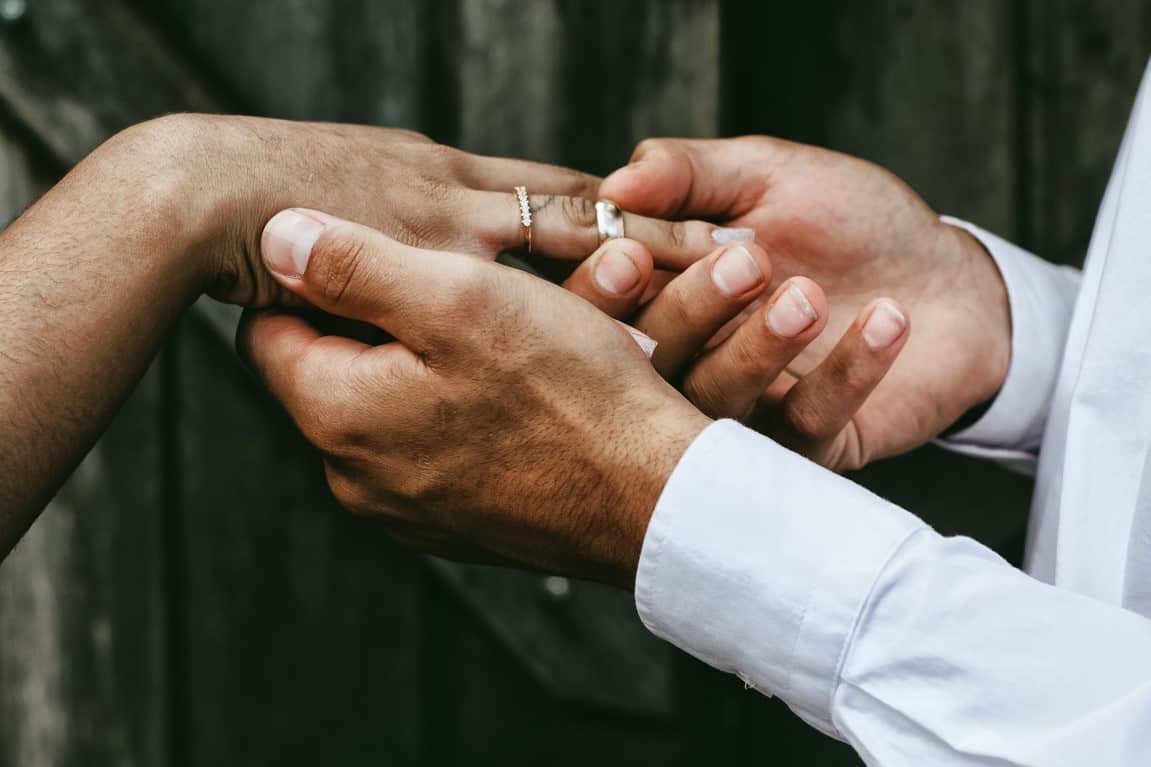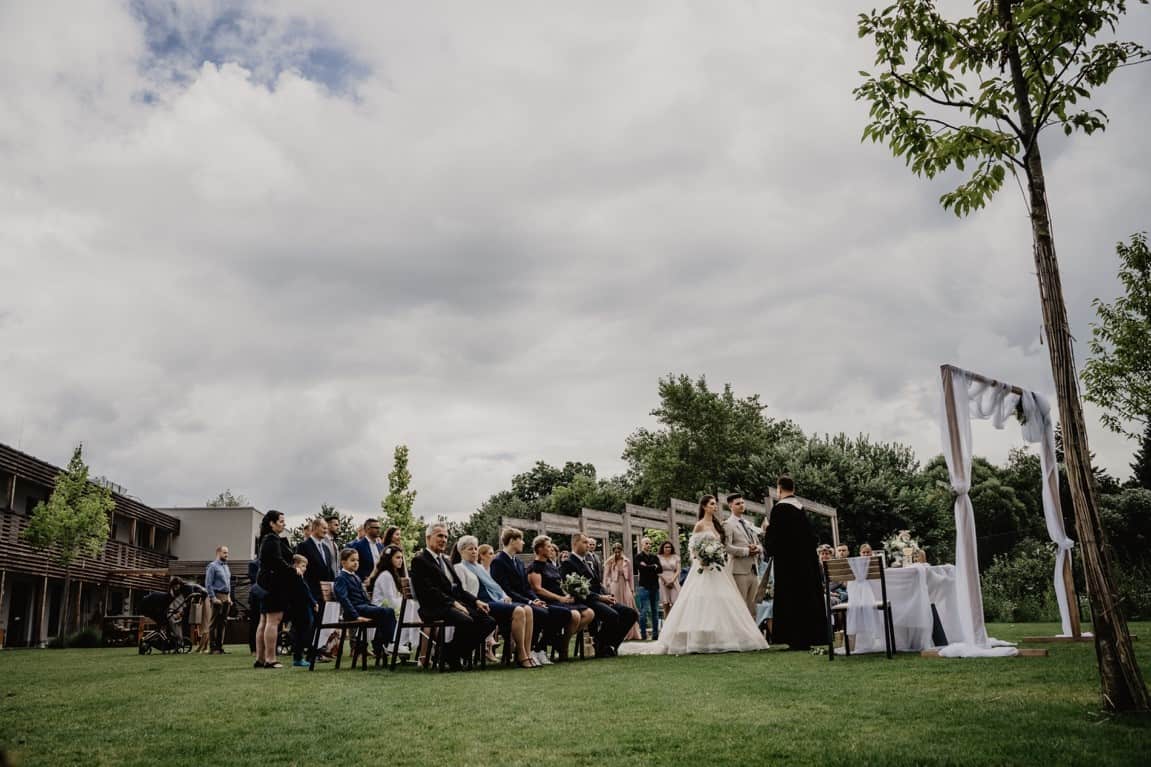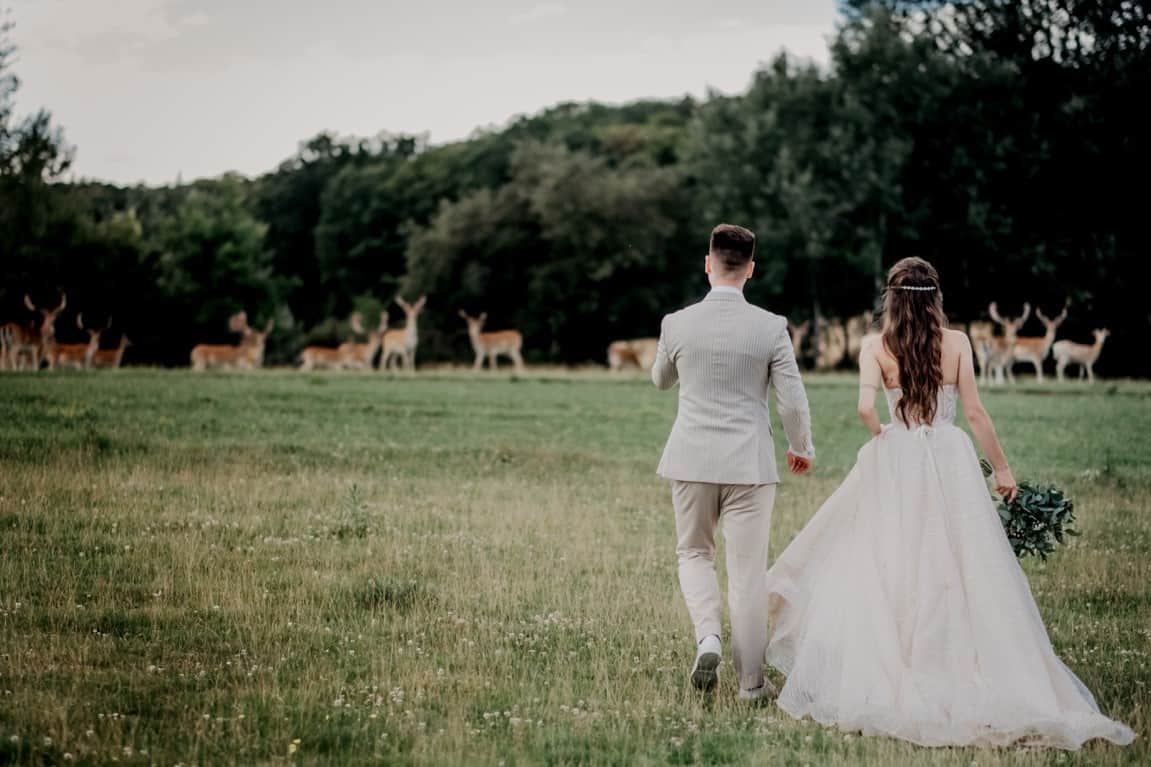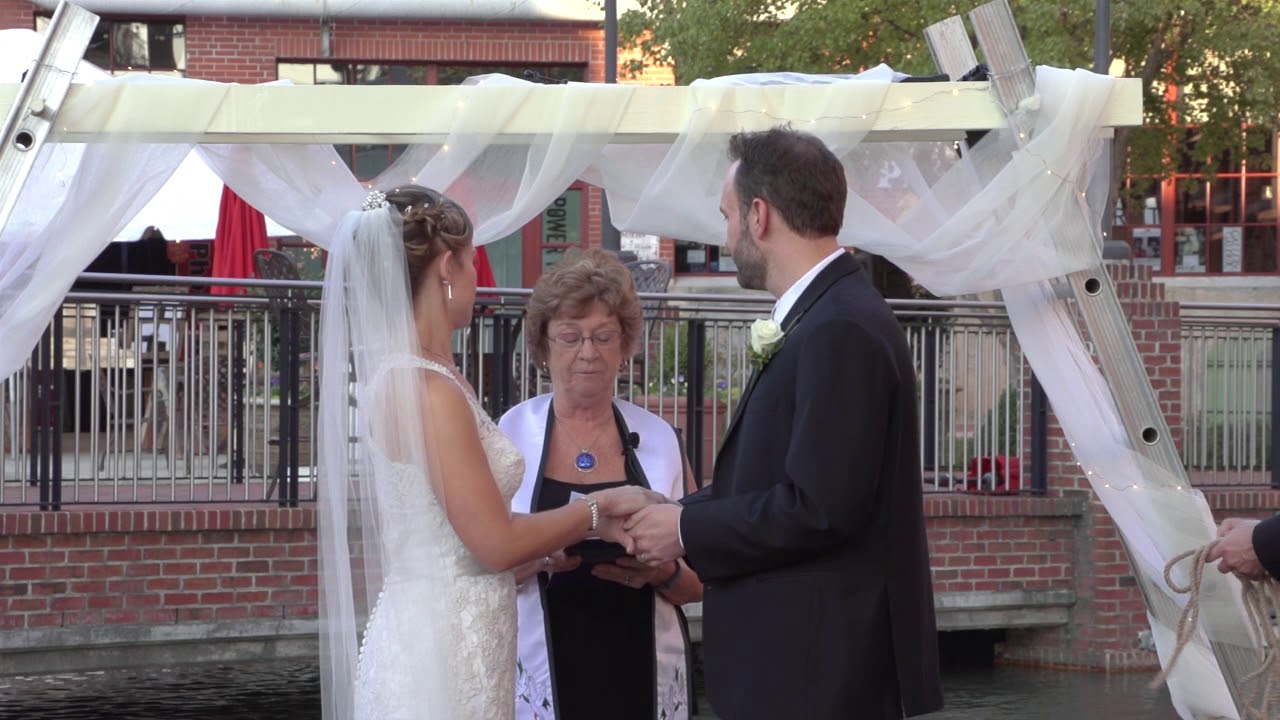A genuine wedding vow is a heartfelt commitment, encapsulating promises that are not only realistic but also dedicated to your partner, your shared future, and the family you are building together. Personalizing these vows makes them even more special and reflective of your bond.
One effective way to personalize wedding vows is to incorporate your religious beliefs and values into the words you pledge. For individuals who practice Paganism, vows often reflect the religion’s core principles, including a deep connection with nature, gender equality, and a commitment to fostering lifelong and meaningful partnerships.
Below, you’ll find twelve examples of Pagan wedding vows that embody these tenets. Each example offers a unique perspective and approach, providing a range of options for couples planning a Pagan wedding ceremony.
Sample Scripts for Pagan Wedding Vows
1.
Being with you for the past three years has been a dream come true. In my heart of hearts, I believe we are two halves of one soul. We are two hearts marching to the beat of the same drum. This ceremony only serves to solemnize our commitment, and I am so happy to finally be able to call you my life partner.

3. Officiant: (Name of Partner A), please give (Name of Partner B) the ring. Do you, (Partner A), vow to respect, honor, and commit to (Partner B), to support (him/her/them) in all endeavors, passions, and dreams? Do you promise to stand by (him/her/them) through thick and thin, through laughter and tears, and to nourish the love you have for each other daily?
Partner A: I do.
Officiant repeats and addresses partner B. After partner B responds, the couple has the option to share individually written vows.
Officiant: The vows of love have been declared. (Partner A) and (Partner B), please cross your hands over one another, and take each other’s hands.
4. I, (your name), take thee, (your partner’s name), to be my partner in life. The Gods have blessed us with a heart capable of love, a body capable of sustenance, and a mind capable of wisdom. I vow to honor these blessings by loving, honoring, and growing with you wholeheartedly and unconditionally.
I vow to hold your hand as we start this journey, to stay by your side as we navigate the physical world. I have loved, currently love, and will love you for who you are, and will support you and your endeavors. I will be there for you in sickness and in health, in good fortune and bad luck, in glee and despair.
5.
Officiant: (Partner A) and (Partner B), do you promise to share one another’s pain and do all you can to relieve them of it?
Partners, in unison: We do.
Officiant: Do you promise to help each other carry your burdens, to allow your souls to flourish in this union?
Partners, in unison: We do.
Officiant: Do you promise to stay positive, to look for the silver linings in life, and to revel in each other’s joy?
Partners, in unison: We do.
Officiant: Do you promise to be supportive of each other’s aspirations?
Partners, in unison: We do.
Officiant: Do you promise to let the heat of anger and frustration fortify the resilience of your partnership?
Partners, in unison: We do.
Officiant: Do you promise to view each other as equals and to act in accordance with this equality?
Partners, in unison: We do.
7.
Officiant: (Partner A) and (Partner B), in front of you, your hands are tied with a cord. This cord represents the coming together of your bodies and spirits and the lifelong bond you two have created. However, the ties of marriage are not forged by this cord nor the knots, but by the sincere and heartfelt vows you shared.
To seal this bond, (Partner A) and (Partner B), will you please share a kiss?
9. After drawing the circle for the ceremony:
Officiant: The circle has been cast, rendering this a blessed space. On this day, we implore the elements to impart their glorious features onto (Partner A), (Partner B), and their union.
From Air, we ask for peace, cheerfulness, and inquisitiveness.
From Fire, we ask for passion, drive, and fearlessness.
From Water, we ask for fortitude, harmony, and creativity.
From Earth, we ask for thankfulness, unity, and growth.
The circle itself has no ends, like a ring with no starting point or ending point. It is unchanging but adaptable. True love is like this circle — it knows no conditions, no restrictions; it is infinite and self-replenishing. Love is a gift that keeps on giving, and we must harness it for ourselves and for others. Love grows and thrives when you nurture it and when you give it the space and care it needs.
10.
11. Pagan Wedding Blood Oath Ceremony
In the sacred space, under the watchful eyes of the gods and goddesses, and surrounded by the energies of the earth and sky, we stand united. As the crimson liquid flows, intertwining with the essence of life, we swear our blood oath in solemnity and reverence.
(At this point, each partner could have a small vessel of red wine or juice, symbolizing the blood.)
Partner 1: With this elixir symbolizing the blood running through my veins, I offer my love, unwavering and eternal. As it mingles with the sacred soil, so does my commitment intertwine with the fibers of your being, steadfast and inseparable.
Partner 2: With the sacred essence representing my life force, I, too, pledge my undying love and devotion. As it blends with the hallowed earth, my promise bonds with your spirit, forming a connection unbreakable and timeless.
(Both partners can pour the red wine or juice onto the ground, or into a shared chalice, then drink from it.)
Together: In witness of the divine and the foundational elements of life, we seal our vows. Let our oath be as enduring as the mountains, as flowing as the rivers, and as deep as the ocean. Forever entwined, our spirits dance together through eternity, honoring and upholding the sacred promise made today.
Remember, this is just a template, and you should feel free to adjust the words and actions to better fit your beliefs, values, and the legal standards in your area.
12. Soulmate Pagan Wedding Vow
Before the grand tapestry of the universe, under the gentle glow of the moon and the twinkling canvas of stars, we stand as two souls destined to entwine and merge into one harmonious melody of everlasting love.
Partner 1: With the sacred earth beneath our feet, providing life and steadfastness, I, [Partner 1’s Name], take thee, [Partner 2’s Name], as my soulmate, the keeper of my heart, and partner through eternity. With the steadfastness of the earth, I vow to be your support, your rock, and your sanctuary, forever anchored and devoted to our shared life.
Partner 2: And I, [Partner 2’s Name], in the presence of the divine and with the ethereal air caressing our faces with whispers of ancient love stories, take thee, [Partner 1’s Name], as my soulmate, my confidant, and my eternal love. With the breath of the air, I pledge to communicate openly, speak truthfully, and listen attentively as we write our own endless love story.
Partner 1: With the passionate fire flickering before us, symbolizing warmth and zest for life, I promise to keep the spark of our love alive, to celebrate our joys fervently, and face challenges with courage and vigor. In every sunrise and each sunset, our love will glow with the brilliance and intensity of fire, illuminating our path.
Partner 2: By the soothing and boundless waters that flow beside us, mirroring the endless skies and depths of our love, I vow to be your harbor, your place of calm, and your partner through the tides of life. Our love shall flow, tender and refreshing, nurturing the gardens of our hearts and quenching our souls’ thirst with its purity.
Together, with hands entwined and hearts aligned, we make these vows, solemn and sacred. As the elements bear witness to our commitment, and the gods and goddesses shower their blessings, we step forth into a life of love, understanding, and eternal companionship.
Feel free to tailor the vows to your personal preferences and beliefs. These are meant to provide a starting point, and the most important thing is that they reflect the unique bond and commitment between you and your partner.
What is a Pagan Wedding?

Paganism refers to a group of religions with roots in pre-Christian Europe. The Paganism we know today takes old pre-Christian rituals, beliefs, and traditions and adds a modern take to them. Modern Paganism is highly influenced by environmentalism, feminism, and other modern value systems. Here are a few religions that belong in the Paganism group:
- Asatru – is a modern recreation of ancient Northern European belief systems. It focuses on the Nine Noble Virtues, including fidelity, truth, and discipline.
- Druidry – takes ancient Celtic rituals and recreates them with an emphasis on literary artistry, such as poetry. It encourages oneness with nature. unity amid diversity, and a harmonious relationship with nature deities and spirits.
- Wicca – as a nature-oriented religion, it emphasizes seasons and their cycles. It is a combination of ancient Pagan practices and hermetic motifs from the 20th century.
In a Pagan wedding ceremony, its central aspect is the tradition of handfasting. The couple’s hands are tied together with a cord, which symbolizes the union and coming together of two people. This tradition is also seen in traditional Scottish weddings, which explains why some of their vows and rituals overlap with those of Pagans.
Pagan marriages are characterized by “loving and equal sexual [partnerships].” The traditional period of a handfast is one year and one day. People in Pagan marriages often renew their vows; they can do it once, which will be valid for the rest of their lives, or they can do it yearly until their death. Believing in reincarnation, some Pagans also pledge to handfast for their next lives.
Location of a Pagan Wedding
Pagan wedding ceremonies are held outdoors. The officiant, typically a high priest or priestess, will mark out a sacred space shaped like a circle; they do this by referring to a compass, facing each point, and honoring the four elements: earth, water, fire, and air.
An altar is placed inside the circle. Besides the traditional cup, knife, and trowel, items representing each element can also be seen on the altar: some salt for earth, a candle for fire, a feather for air, and a bowl of water.
Parts of a Pagan Wedding

- Entrance. It is important for Pagan couples to honor their families and ancestors. No “sending off” or “giving away” the bride is performed, as Pagan marriages give importance to equality. Couples typically enter the marked circle from the east, signifying the growth of their partnership.
- Welcome statement. The officiant will first address the congregation with a welcome statement. The couple is introduced to the guests to formally begin the ceremony.
- Invocation. The officiant will speak to the couple, urging them to care for each other, always seek good, and nurture their love for one another. Pagans believe that marriage is a gift, and it grants the couple the “divine magic” of lifelong love.
- Reading. Before the ceremony, the couple can choose what they would like to be read at their wedding. The officiant will be the one to speak.
- Elemental blessing. As illustrated above, Pagan weddings honor four elements: earth, water, fire, and air. Each element has features that Pagans revere, such as strength, courage, humility, and peace. An elemental blessing is essential for the longevity of the partnership.
- Declaration of intent. In this part of a Pagan wedding, the couple reads their vows and makes promises for their future together. This can be a traditional vow uttered by the officiant and repeated by the couple, or the couple can write their own vows.
- Handfasting. This wedding tradition typically accompanies the couple’s declaration of intent and exchange of Pagan wedding vows.
- Ring exchange.
- Pronouncement. The officiant pronounces the couple “lawfully and spiritually” wed for life and beyond it. The couple kisses and everyone will stand up as the couple walks down the aisle to exit.
It is important to remember that every couple is different; they may want to include other parts and wedding traditions from their culture. For instance, they can include other unity ceremonies, such as the unity sand ceremony or the jumping of the besom broom. The cutting of each other’s hair, as often seen in Cambodian weddings, is also practiced by Pagans.
What Is the Handfasting Ceremony?
Firstly, the officiant will explain the procedure and significance of the handfasting ceremony. They will call on the couple to take each other’s hands, signifying the free will involved in the marriage. As the vows are said, the cords will be tied or braided by the officiant. However, this can also be done by the couple’s relatives or friends.
The officiant can also impart some advice to the couple and their partnership. This includes how to keep the relationship healthy, stay strong amid difficulties, and so on. The officiant may also ask the guests for their approval of the marriage.
Couples are free to decide the material and amount of the cords they will use. However, three cords are commonly utilized to make braiding possible. The cord is usually about a yard long. You have the freedom to decide what colors the cord will be; you can coordinate with your color scheme, or you can look into the symbolism of each color.
Historically, couples had to wear the knots until midnight. However, in modern practice, you can also take them off after the ceremony. Ultimately, this depends on you and your partner’s preferences. You may want to preserve the knot while taking it off, though, so you can keep it as a memento for your special day.
Are Pagan Weddings Legally Recognized?

By definition, Pagan weddings are religious ceremonies. However, Pagan weddings can also fall under several types of a wedding ceremonies: it can be a commitment ceremony for a marriage in the future; it can also be a formal wedding, which is elaborate and structured events; it can also be an informal wedding, which is more relaxed compared to formal ones.
Given that Paganism is not a major religion, the number of Pagan clergies who are also legally ordained to act as officiants is limited. As such, couples can take care of the legal aspect of the union first through a civil ceremony before proceeding with a Pagan wedding.
Final Thoughts
Modern Paganism is a spiritual movement gaining more momentum as time goes by. As with any religion, each person has a different relationship to it. While discussing your marriage, you and your partner should be open about how much you want religion to influence your ceremonies. Based on that discussion, Pagan wedding vows may or may not be a perfect addition to your special day.
